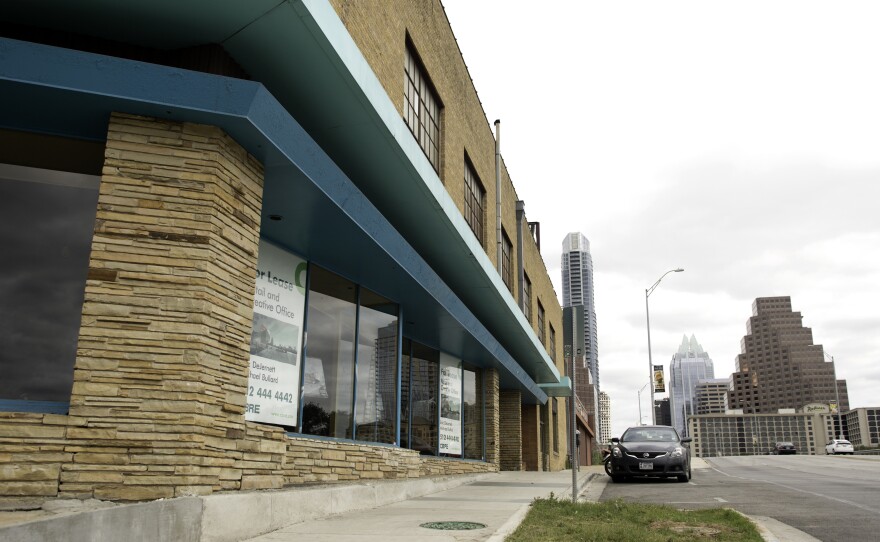For the past 10 years, the Austin skyline’s been in a state of constant flux. In the past year alone, two towers have gone up in the downtown area: the Colorado Tower and the IBC Bank Plaza. Those two buildings, which combine for nearly 570,000 square feet in office and retail space, were all but leased by the time they opened their doors.
But, for some buildings, the wait is a little longer.
For some buildings – like the former headquarters of La Bare on Riverside Drive, the boxy little historic building at Congress and Riverside just down the road, and even some properties in the heart of Downtown Austin, just a few blocks from the Capitol – the wait is seemingly interminable, leaving daily passersby wondering why such high-value real estate lies vacant in the middle of a Austin’s development boom.
Obviously, the downtown real estate market hasn’t always been so hot.
“The banking industry, the agricultural industry, the oil-and-gas industry and real estate all kind of went in the tank at one time during that time period of the early to mid-'80s,” says chair of the Downtown Austin Alliance Jerry Frey. “There was probably about three-and-a-half million square feet of office space in downtown, for instance. Four buildings went up all at the same time, and that put on the market almost another two million square feet. So...the office space in downtown doubled in an 18 to 24-month period, and then there was a lot of vacancy.”
Now that’s not the case. The downtown area has a commercial vacancy rate of about eight percent, according to Frey. And those long-vacant properties are typically retail or residential developments, often waiting for the right master plan to develop. But sometimes the owners aren’t exactly right down the street.
Out of Sight, Out of Mind
Just two blocks from the Capitol, right next to a Quizno’s, is a long-vacant space at 920 Congress. Built in 1900, the space was bought by Harley and Nancy Sullivan in 2008, according to the Travis County Appraisal District. Filmmaker Robert Rodriguez rented out the space over South by Southwest to showcase some of cult artist Frank Frazetta’s paintings. But other than that, the $1.1 million space has sat in relative limbo.
“When you do stumble upon a highly visible property, and it’s vacant, you scratch your head like ‘why?’” says Jude Galligan, a downtown realtor and part-time real estate blogger. “Usually it’s not nefarious. Often, the landowners have owned them for years. Maybe they don’t live in Austin, or maybe it’s part of a family trust, a huge trust with multiple hands involved.”
That’s the case at 920 Congress. The space is currently connected to both 920 Condominiums LLC and 10th at Congress Condominium Owners Association. According to paperwork filed with the Texas Comptroller, both entities list the Sullivans as managers. And 920 Congress LLC, the owner of the properties, has a New Braunfels mailing address.
While the building may one day develop into condominiums, it’s likely that it being a historical landmark has made the build-out all the more tricky.
Arrested Development
Across the street are perhaps the three most visible vacant properties: 907, 909 and 911 Congress. The three gritty, boarded-up buildings are a departure from the tidy, glass- and granite-bound towers it neighbors.
“It’s obviously not something that would be leased in its current condition, so it’s more of a redevelopment play,” Frey says. “The dirt underneath that is obviously very valuable having Congress Avenue frontage, and they are pending redevelopment, but they don’t have a lot of land. So it is problematic in some respects.”
In 2010, the owner and potential developer Dalton Wallace attempted to renovate and build out the properties, adding storefronts and a 16-story tower for commercial space, but the plan didn’t come to fruition.

After citations from Code Compliance in 2011, the three buildings received designations for “demolition by neglect” from the city’s Historical Landmark Commission last year. The designation, according to the National Trust for Historic Preservation, implies that an owner “intentionally allows a historic property to suffer severe deterioration, potentially beyond the point of repair. It’s a designation that requires the city’s approval of a plan to either rehabilitate the property or tear it down completely.
All three buildings have historical designations – 907 and 909 are both historic landmarks, built in 1925 and 1895, respectively, and 911, which was built in 1890 is a part of the Congress Avenue Historic District.
“The buildings have been vacant for quite some time,” says Steve Sadowsky of the Historical Landmark Commission. “There was quite a bit of movement on the buildings probably eight to 10 years ago, and that stopped. So basically the buildings have kind of been frozen in time.”
Sadowsky says the city’s currently working with the owner to redevelop the site, which began just after the commission declared the demolition by neglect status in February of 2014. He says the process is lengthy, as developers must meet the commission’s standards, which can drag the process out.
Further on Down the Road
Unlike the Congress sites, the former site of Le Bare at 110 E. Riverside and the boxy building at 220 Congress have made the transition from long-vacant to on-the-market. 220 South Congress was purchased by Cielo Properties late last year and is being redeveloped for commercial use, with international architectural firm Gensler revamping the space. The Le Bare site is currently for lease.
But like the Congress sites, they were both vacant for the better part of a decade. Frey says both vacancies are indicative of Austin’s current market – projects tend take a while to get off the ground and, at least for 220 South Congress, historical status can also gum up the works, as with the downtown properties.
“Many years ago, the standards for financing for commercial properties were a lot looser, and it was a lot easier for projects to get off the ground. Now these projects have to be well-conceived,” he says. “So, on the supply side, basically what we’re seeing in today’s market is you have projects that are pre-leasing to an extent where the risk is minimized, so that you’re not putting a lot of new vacant supply on the market.”

Such is the case with 220 Congress. Weeks after the three-story, 26,280-square foot space went up for lease, it’s been completely leased, according to real estate database LoopNet.
While the former La Bare property may be on the market, it’s still unclear what will become of the former site of the “Ultimate” ladies’ club. For the moment it’s in limbo, but the fact that it’s gone to market means it may not languish in vacancy for long.
La Bare’s not alone. There’s the space occupied by Antone’s, the former Jack in the Box on Guadalupe (which inspired a KUT Tumblr called Jack Watch), Headhunters on Red River and dozens more properties.
Still, while they may stick out like a sore thumb, the retail vacancy rate in Austin is slightly lower than its commercial vacancy rate, hovering at around seven percent, according to Integra Realty Resources.







